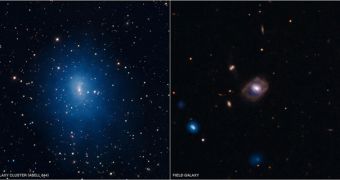In their studies of the universe, astronomers have found a large number of black holes of various shapes, sizes and types, but they have always been fascinated about why some of these dark behemoths are so much more active than others. A new study sheds some light on the possible answers.
One of the things setting active black holes apart from others is the tremendous light show they display, especially when viewed in the X-ray portion of the electromagnetic spectrum.
Astrophysicists now know that these radiations are emitted as superheated gas from black holes' accretion disks fall through the event horizon. Some of this matter is converted, and released as energy.
Using data collected by a large-scale survey of galaxies, experts now believe they may have narrowed down the possible answers to this mystery. More than 100,000 galaxies were analyzed in the study.
Relevant datasets were collected from the Sloan Digital Sky Survey (SDSS) and also by the NASA Chandra X-ray Observatory. A huge portion of the night sky was covered by these instruments.
Of the galaxies surveyed, only one percent – roughly 1,600 – were brighter than usual in X-rays. This means that only the cores of these formations contained active black holes making a scandal.
“Trying to figure out how many of these black holes are active at any time is important for understanding how black holes grow within galaxies, and how this growth is affected by the environment,” explains Daryl Haggard.
The researcher holds joint appointments, at the University of Washington in Seattle and at the Northwestern University, in Evanston, Illinois, and was also the leader of the new study.
All the galaxies studied in this research were mostly located within 1.6 billion light-years from Earth, and were so-called loner galaxies, as in not included in any clusters. The most distant study targets were located some 6.3 billion light-years away.
One of the most interesting discoveries in the new research was that the mass of the host galaxy appeared to be directly connected to the level of activity the black hole at its core exhibited.
It was also found that the number of hyperactive galaxies has been experiencing a declining trend since the first galaxies appeared after the Big Bang. In other words, most such formations existed when the Universe was very young.
“It seems that really active black holes are rare but not antisocial. This has been a surprise to some, but might provide important clues about how the environment affects black hole growth,” Haggard says.
The study also shows that galaxies in clusters were equally as likely to contain active black holes as loner galaxies, something that had never been detected before, Space reports.
The black hole at the core of the Milky Way is not hyperactive, otherwise it would show on our scans. This is good news, given that otherwise, huge amounts of radio and X-ray radiation would batter Earth.

 14 DAY TRIAL //
14 DAY TRIAL //